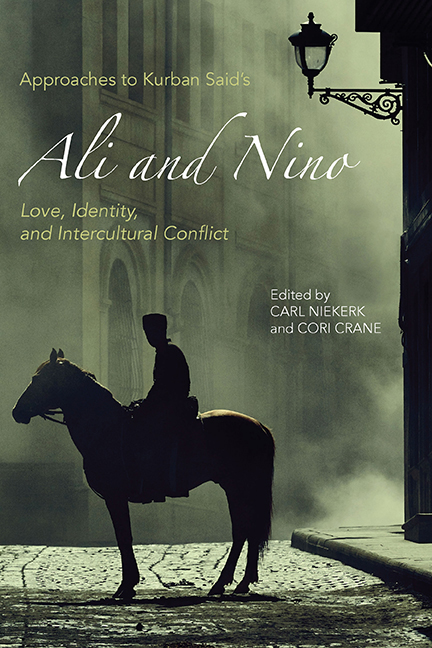Book contents
- Frontmatter
- Contents
- Acknowledgments
- Notes on Editions of and References to Ali and Nino
- Introduction: Ali and Nino as World Literature
- 1 Ali and Nino: The Novel as/of Cultural Translation
- 2 Crossing Borders, Crossing Disciplines: Ali and Nino in the Twenty-First Century
- 3 Glowing Rubies and Persian Daggers: The Role of Persian Poetry in Ali and Nino
- 4 Gendered Stereotypes and Cross-Cultural Moral Values through the Eyes of Kurban Said
- 5 Orientalist Itineraries: Cultural Hegemony, Gender, Race, and Religion in Ali and Nino
- 6 Gendered Conflicts in Muslim and Christian Cultures: Honor (and Shame) in Ali and Nino
- 7 Love and Politics: Retelling History in Ali and Nino and Artush and Zaur
- 8 “Herr Professor, Please: We'd Rather Stay in Asia”: Ali Khan Shirvanshir and the Spaces of Baku
- 9 The Female Body and the Seduction of Modernity in Ali and Nino
- 10 Seeing the Unseen: Symbolic Writing in Ali and Nino
- 11 Ali and Nino and Jewish Questions
- 12 Between Orientalism and Occidentalism: Culture, Identity, and the “Clash of Civilizations” in Ali and Nino
- Works Cited
- Notes on the Contributors
- Index
12 - Between Orientalism and Occidentalism: Culture, Identity, and the “Clash of Civilizations” in Ali and Nino
Published online by Cambridge University Press: 30 August 2017
- Frontmatter
- Contents
- Acknowledgments
- Notes on Editions of and References to Ali and Nino
- Introduction: Ali and Nino as World Literature
- 1 Ali and Nino: The Novel as/of Cultural Translation
- 2 Crossing Borders, Crossing Disciplines: Ali and Nino in the Twenty-First Century
- 3 Glowing Rubies and Persian Daggers: The Role of Persian Poetry in Ali and Nino
- 4 Gendered Stereotypes and Cross-Cultural Moral Values through the Eyes of Kurban Said
- 5 Orientalist Itineraries: Cultural Hegemony, Gender, Race, and Religion in Ali and Nino
- 6 Gendered Conflicts in Muslim and Christian Cultures: Honor (and Shame) in Ali and Nino
- 7 Love and Politics: Retelling History in Ali and Nino and Artush and Zaur
- 8 “Herr Professor, Please: We'd Rather Stay in Asia”: Ali Khan Shirvanshir and the Spaces of Baku
- 9 The Female Body and the Seduction of Modernity in Ali and Nino
- 10 Seeing the Unseen: Symbolic Writing in Ali and Nino
- 11 Ali and Nino and Jewish Questions
- 12 Between Orientalism and Occidentalism: Culture, Identity, and the “Clash of Civilizations” in Ali and Nino
- Works Cited
- Notes on the Contributors
- Index
Summary
ON THE COVER OF the most recent German edition of Kurban Said's 1937 novel Ali and Nino is a black-and-white picture of a woman who is identified on the book's copyright page as Elfriede von Ehrenfels von Bodmershof. The same edition contains the following statement about the text's author(s):
Kurban Said is an alias for the publicist Elfriede von Ehrenfels, born in 1894, and presumably for the coffee-house-litterateur Lev Nussimbaum (1905–1942). Both moved in Vienna's bohemian circles; the Jew Nussimbaum converted to Islam. Who wrote which part of the love story will probably remain a mystery forever.
[Kurban Said ist ein Pseudonym, hinter dem sich die 1894 geborene Publizistin Elfriede von Ehrenfels und vermutlich der Kaffeehausliterat Lev Nussimbaum (1905–1942) verbergen. Beide bewegten sich in der Wiener Boheme; der Jude Nussimbaum konvertierte zum Islam. Wer welchen Anteil an der Liebesgeschichte hatte, wird wohl immer ein Geheimnis bleiben. (2)]
The authorship of Elfriede von Ehrenfels—the woman on the cover— is given as certain, while the adverb “presumably” (vermutlich) suggests that Lev (Leo) Nussimbaum's role in the text's genesis only can be assumed. The slightly pejorative term “coffee-house-litterateur” (Kaffeehausliterat) describes Nussimbaum, while “publicist” (Publizistin) in German evokes intellectual seriousness and professionalism. Something similar is going on in the afterword to the Englishlanguage paperback edition of Ali and Nino, published in 2000. The afterword was penned by Dr. Heinz Barazon, a lawyer for Leela Ehrenfels, Elfriede von Ehrenfels's niece and the current copyright holder of Ali and Nino. Barazon claims that Kurban Said is a pseudonym for two people, Elfriede von Ehrenfels and Lev Nussimbaum, that the original idea for the novel may have been Nussimbaum's, and that the book is “almost certainly” the product of cooperation between the two. He concludes, “Which sections of the novel are the work of which author remains an unsolved mystery” (282). The idea that Ali and Nino is the product of the work of two authors is a rather new one. Interestingly, the English-language edition of Ali and Nino published in 1970 mentions only one author: “A man who was, by nationality, a Tartar. He escaped from his own country to Vienna and was forced to flee again when the Nazis came.
- Type
- Chapter
- Information
- Approaches to Kurban Said's Ali and NinoLove, Identity, and Intercultural Conflict, pp. 227 - 250Publisher: Boydell & BrewerPrint publication year: 2017

